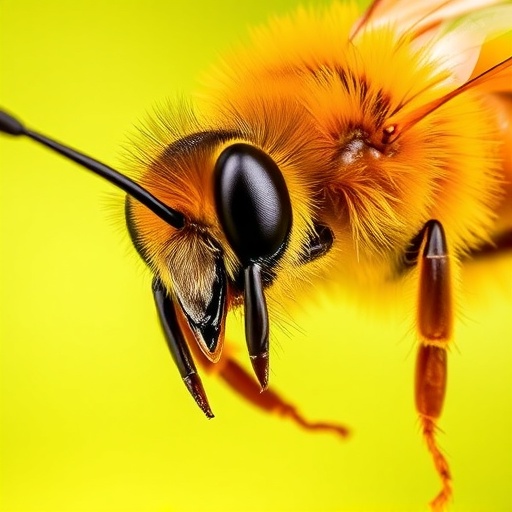In a groundbreaking study published in Front Zool, researchers led by Liu, F., along with co-authors Lai, Y., and Wu, L., have unveiled the intricate role of the AmelOBP4 gene in the olfactory behavior of honey bees (Apis mellifera). The findings reveal that this antenna-specific odor-binding protein is vital for the sensory perception of these insects. This research crochets a deeper understanding of how honey bees interpret their environment, which has profound implications on both ecological systems and agricultural practices where these pollinators play an indispensable role.
Honey bees are celebrated for their remarkable ability to recognize and respond to a myriad of odors, which is essential for foraging and communication within their colonies. The AmelOBP4 gene was identified through comparative analyses in honey bee antennae, signaling its importance in the olfactory system. This study meticulously details how this specific odor-binding protein operates at the molecular level and bridges the gap between environmental stimuli and behavioral responses.
The researchers utilized a combination of genetic manipulation and behavioral assays to assess the impact of AmelOBP4 on olfactory responses. By knocking down the expression of this gene, the team observed significant changes in the bees’ ability to respond to floral scents. These findings usher in a new era of understanding the molecular underpinnings of olfactory perception in honey bees, a topic of growing interest within the scientific community.
Additionally, the study encompassed thorough analyses of honey bee behavior post genetic modification. Bees that exhibited reduced levels of AmelOBP4 displayed difficulties in locating food sources that relied on specific odor cues. The diminished olfactory capabilities reveal just how integral this protein is for honey bee survival, especially in environments where scent plays a pivotal role in navigation and food discovery.
Beyond the immediate implications for honey bee behavior, the research also touches on broader ecological contexts. Honey bees are crucial pollinators in various ecosystems, and their foraging efficiency directly affects flowering plant reproduction. By elucidating the mechanisms of olfactory signals and responses in bees, the study provides insight into factors that may influence bee populations and health, ultimately impacting biodiversity.
The context of this study also aligns with ongoing discussions about pollinator health, as honeys bees face numerous threats, including habitat loss, pesticide exposure, and climate change. Understanding the genetic and protein-based factors influencing honey bee behavior can thus inform conservation strategies aimed at preserving these vital species. The insights gleaned from AmelOBP4 research might enable scientists and environmentalists to devise targeted interventions that can help bolster honey bee populations against existential threats.
Furthermore, the implications of this research may extend to agricultural strategies. Many crops rely on honey bees for pollination, and understanding the sensory processes that underlie foraging can optimize those interactions. If farmers understand which scents attract bees most effectively, they might enhance planting strategies or use floral baiting techniques to improve pollination rates, ultimately boosting crop yields.
Another interesting facet of the study is its approach to molecular biology techniques, which could be applied to other areas of insect research. The methodologies used to manipulate gene expression and measure behavioral changes demonstrate a framework that can be echoed in studies of other pollinators and beneficial insects. This approach could lead to new discoveries in ecological genetics and enhance our understanding of the sensory experiences of various species.
While the study focuses on honey bees, the insights gained from investigating AmelOBP4 might teach us about insects’ sensory systems more broadly. For example, many other pollinator species share ecological niches with honey bees. Comparative studies might unveil similar genes and proteins in different species, deepening our understanding of the evolution of olfactory systems across the animal kingdom.
This research further emphasizes the interconnectivity of genetic research and practical applications in the real world. It unequivocally illustrates how much we can learn from studying the genetic basis of behavior in organisms as important as honey bees. The AmelOBP4 research stands as an emblem of the intersection between pure scientific inquiry and the urgent need for actionable solutions in conservation and agriculture.
In essence, the groundbreaking findings of Liu and colleagues can catalyze a paradigm shift in how we regard honey bee behavior and the genetic elements underpinning it. As the world’s ecosystems grapple with the mounting pressures of anthropogenic activities, the insights from this study stand to offer hope for bolstering the resilience of pollinator populations. Thus, ongoing inquiries into the genetic and molecular frameworks of honey bees are critical for ensuring their survival and, by extension, the health of our agricultural ecosystems.
Indeed, the AmelOBP4 investigation is a rallying call for researchers, conservationists, and agriculturalists alike to focus on genetic studies that can yield innovative strategies to protect and empower honey bee populations. The fusion of molecular biology with environmental science reveals profound truths about these indispensable insects and sets a course for future inquiry that is as vital as it is exciting.
In conclusion, the research on AmelOBP4 acts as a linchpin joining the disciplines of genetics, ecology, and agriculture, forming a comprehensive understanding of honey bee olfactory behavior. The implications of this work are multifaceted, promising to enhance our approaches in conservation, inform agricultural practices, and foster a more profound appreciation of the delicate symbiosis that exists within our ecosystems. This is indeed just the beginning of a deeper exploration into the sensory worlds of honey bees and how they navigate the life-sustaining scents of their environment.
Subject of Research: The olfactory behavior of honey bees (Apis mellifera) and the role of the AmelOBP4 gene.
Article Title: AmelOBP4: an antenna-specific odor-binding protein gene required for olfactory behavior in the honey bee (Apis mellifera).
Article References:
Liu, F., Lai, Y., Wu, L. et al. AmelOBP4: an antenna-specific odor-binding protein gene required for olfactory behavior in the honey bee (Apis mellifera). Front Zool 22, 2 (2025). https://doi.org/10.1186/s12983-024-00554-y
Image Credits: AI Generated
DOI: 10.1186/s12983-024-00554-y
Keywords: Honey bees, olfactory behavior, AmelOBP4, pollination, genetics, environmental impact.




